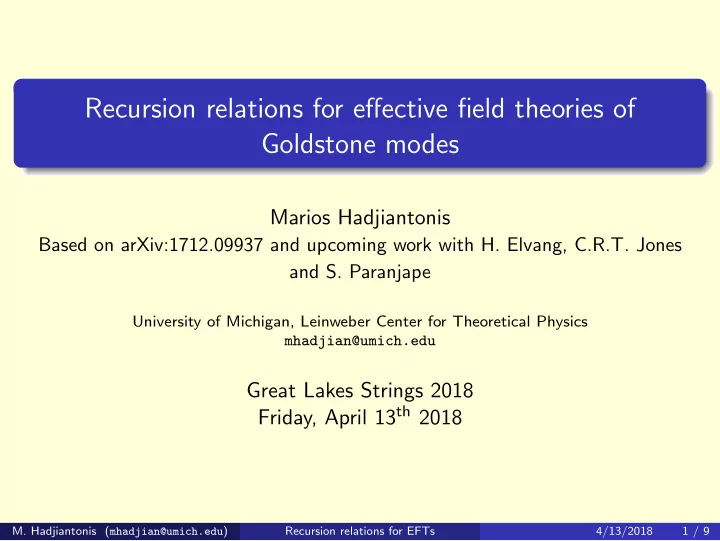

Recursion relations for effective field theories of Goldstone modes Marios Hadjiantonis Based on arXiv:1712.09937 and upcoming work with H. Elvang, C.R.T. Jones and S. Paranjape University of Michigan, Leinweber Center for Theoretical Physics mhadjian@umich.edu Great Lakes Strings 2018 Friday, April 13 th 2018 M. Hadjiantonis ( mhadjian@umich.edu ) Recursion relations for EFTs 4/13/2018 1 / 9
Our goal Use on-shell amplitude methods like Recursion relations Ward identities Low-energy theorems to understand effective field theories (EFTs) that can arise from spontaneous symmetry breaking M. Hadjiantonis ( mhadjian@umich.edu ) Recursion relations for EFTs 4/13/2018 2 / 9
Background [C. Cheung et al., 1509.03309 ] introduced so-called “Subtracted soft recursion relations” for tree-level scattering amplitudes for effective field theories of massless scalars Use Locality → Simple poles when internal lines go on-shell Unitarity → Residue at poles is a product of lower-point amplitudes Low-energy theorems (Vanishing of amplitude when the momentum of an external state goes to 0) to reconstruct all amplitudes of theory from a finite set of input amplitudes M. Hadjiantonis ( mhadjian@umich.edu ) Recursion relations for EFTs 4/13/2018 3 / 9
Recursion relations for arbitrary spin We generalized the recursive approach to amplitudes of particles of arbitrary spin We derived a precise criterion for when a subtracted soft recursion relation has to to be valid 4 − n − n − 2 � � v − 2[ g ] − s i − σ i < 0 i i n : number of external states of amplitude v : valence of fundamental interaction [ g ] : mass dimension of fundamental coupling s i : spin of external state σ i : soft degree of amplitude for given external state p i → ǫp i ǫ → 0 → ǫ σ i A n − − − − − M. Hadjiantonis ( mhadjian@umich.edu ) Recursion relations for EFTs 4/13/2018 4 / 9
Recursion relations for arbitrary spin We use our method to explore the landscape of effective field theories For the values of [ g ] and σ that we know our recursion relations must be valid Write the most general form for the input amplitude Apply recursion relations to calculate higher-point amplitudes If the result of recursion has unphysical poles ⇒ There cannot be a theory with the given [ g ] and σ If there are no unphysical poles ⇒ A theory may exist and we study its properties from the calculated amplitudes. M. Hadjiantonis ( mhadjian@umich.edu ) Recursion relations for EFTs 4/13/2018 5 / 9
An example - The quartic Galileon Quartic Galileon interactions have 6 derivatives ( [ g ] = − 6 ) Action has to be invariant under the shift φ → φ + c + b µ x µ ⇒ Amplitudes must vanish as p 2 soft Constructibility criterion 4 − n + 6 2( n − 2) − 0 − 2 n < 0 ⇒ − 2 < 0 holds for any positive integer n M. Hadjiantonis ( mhadjian@umich.edu ) Recursion relations for EFTs 4/13/2018 6 / 9
An example - The quartic Galileon Expecting supersymmetry, the only allowed 4-scalar amplitude has 2 φ ’s and 2 ¯ φ ’s, i.e. A 4 ( φ ¯ φφ ¯ φ ) Most general Ansatz A 4 ( φ ¯ φφ ¯ c 1 stu + c 2 t 3 � � φ ) = g Apply recursion to calculate A 6 ( φ ¯ φφ ¯ φφ ¯ φ ) Reconstructed amplitude has spurious poles unless c 2 = 0 With c 2 = 0 , 4 and 6-scalar amplitudes match the ones calculated from the Lagrangian of [K. Hinterbichler et al. 1008.1305] using traditional methods - Feynman diagrams M. Hadjiantonis ( mhadjian@umich.edu ) Recursion relations for EFTs 4/13/2018 7 / 9
Landscape of reconstructible EFTs M. Hadjiantonis ( mhadjian@umich.edu ) Recursion relations for EFTs 4/13/2018 8 / 9
More aspects of our work Supersymmetrization of Galileon theories Study EFTs arising from spontaneous supersymmetry breaking Explore “emergent” symmetries in these EFTs M. Hadjiantonis ( mhadjian@umich.edu ) Recursion relations for EFTs 4/13/2018 9 / 9
More aspects of our work Supersymmetrization of Galileon theories Study EFTs arising from spontaneous supersymmetry breaking Explore “emergent” symmetries in these EFTs THANK YOU! M. Hadjiantonis ( mhadjian@umich.edu ) Recursion relations for EFTs 4/13/2018 9 / 9
Recommend
More recommend